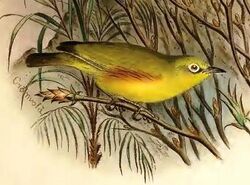Biology:Marianne white-eye
| Marianne white-eye | |
|---|---|

| |
| Illustrated by Henrik Grønvold | |
| Scientific classification | |
| Domain: | Eukaryota |
| Kingdom: | Animalia |
| Phylum: | Chordata |
| Class: | Aves |
| Order: | Passeriformes |
| Family: | Zosteropidae |
| Genus: | Zosterops |
| Species: | Z. semiflavus
|
| Binomial name | |
| Zosterops semiflavus E. Newton, 1867
| |

| |
| Marianne Island in red (top right) | |
| Synonyms | |
| |
The Marianne white-eye (Zosterops semiflavus), also known as Seychelles chestnut-sided white-eye or Seychelles yellow white-eye, is an extinct species of small bird in the white-eye family.
Taxonomy
Edward Newton described it as a full species Zosterops semiflava in 1867, though subsequently it was considered a subspecies of the Mayotte white-eye. After a 2006 study showed[1] that the Marianne white-eye is more closely related to the Karthala white-eye from Grande Comore and the white-eyes from the Mascarenes, the IOC restored it to a full species.[2] The IUCN recognized it as full species in 2016.
Description
It reached a size of 10 cm (3.9 in), the wing length was 5.8 to 6.3 cm (2.3 to 2.5 in), the length of the tail was 3.8 cm (1.5 in) and the length of the culmen 1.1 to 1.2 cm (0.43 to 0.47 in). It was generally greenish yellow with chestnut-coloured flanks and a conspicuous white eye-ring. The forehead and a line above the eyes were yellow. The top of the head and the back were yellow olive. The wings and the tail were black and the underparts were pale yellow. It was similar in appearance to the Mayotte race of the Malagasy white-eye (Zosterops maderaspatanus mayottensis). Nothing is known of its ecology.[3]
Distribution and habitat
It is known with certainty only from the small granitic islet of Marianne Island [0.962 sq mi (2.49 km2)] in the Seychelles about 6 km (3.7 mi) east of La Digue. Reports that it also occurred on Praslin, La Digue, Silhouette Island and Mahé are unconfirmed. Due to the habitat destruction through agricultural development it apparently became extinct between 1870 and 1900 (according to IUCN around 1888). An expedition in 1940 led by Irish zoologist Desmond Vesey-Fitzgerald failed to find it. There is one specimen in the Natural History Museum in London.[4]
Footnotes
- ↑ Warren et al.: Immigration, species radiation and extinction in a highly diverse songbird lineage: white-eyes on Indian Ocean islands. In Molecular Ecology Blackwell Publishing Ltd, 2006. doi:10.1111/j.1365-294X.2006.03058.x.
- ↑ IOC World Bird list
- ↑ Safford, Roger; Hawkins, Frank (2013). The Birds of Africa: Volume VIII: The Malagasy Region: Madagascar, Seychelles, Comoros, Mascarenes. A&C Black. pp. 792. ISBN 978-0-7136-6532-1. https://books.google.com/books?id=qaFLAQAAQBAJ&pg=PA792.
- ↑ Milá, Borja; Warren, Ben H; Heeb, Philipp; Thébaud, Christophe (2010). "The geographic scale of diversification on islands: genetic and morphological divergence at a very small spatial scale in the Mascarene grey white-eye (Aves: Zosterops borbonicus)". BMC Evolutionary Biology 10 (158): 158. doi:10.1186/1471-2148-10-158. PMID 20504327.
References
- Greenway, James C. (1967): Extinct and Vanishing Birds of the World
- Luther, Dieter (2005): Die ausgestorbenen Vögel der Welt
Wikidata ☰ Q1766876 entry
 |


